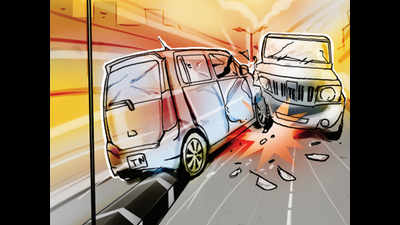- News
- City News
- ahmedabad News
- 4 stretches see 26% of road deaths in Ahmedabad
Trending
This story is from June 9, 2019
4 stretches see 26% of road deaths in Ahmedabad
Of the 308 fatal accidents recorded by Ahmedabad traffic police in 2018, 26% occurred on just four stretches, reveals an analysis by Cept University

Picture used for representational purpose only
AHMEDABAD: Of the 308 fatal accidents recorded by Ahmedabad traffic police in 2018, 26% occurred on just four stretches, reveals an analysis by Cept University.

The study considered the FIRs registered by the Ahmedabad traffic police and mapped the locations to ascertain accident-prone zones. The study notes that while the absolute number of accidents has come down by 38% in 12 years — 2,599 in 2006 to 1,608 in 2018, fatal accidents have increased from 9% to 19%.
Suruchi Mehta, a final-year student of Bachelor of Construction Technology at Cept University, carried out the study as her dissertation under the guidance of Prof Bhargav Adhvaryu of the faculty of technology at the university.“We identified the stretches from Gota Crossroads to Sanand Crossroads, Sanand Crossroads to Vishala Circle, Narol Circle to Naroda Patia and Lal Gebi Circle to Ranasan Circle as the most accident-prone zones in and around the city, responsible for a quarter of the total fatal accidents,” said Mehta, adding that the Narol-Naroda stretch recorded 1.71 accidents per km, Ranasan to Lal Gebi 1.58, and Vishala to Gota via Sanand Circle 1.35.
Prof Adhvaryu said that the analysis of these stretches along with victim-accused vehicle profiles showed that there is a dire need for pedestrian infrastructure in the city. Last year, 133 non-vehicle users died in accidents. “Safe crossings should be a priority along with the re-designing of key intersections that can prevent over-speeding,” he said. “We also observed poor lighting during night hours and road dividers broken at strategic places by locals for easier turns not allowed by the design.”
The researchers emphasized the perfect balance of the three Es of road safety: engineering, enforcement, and education.
“Citizens by and large have started following traffic lights even at non-peak hours which is a welcome development,” said Prof Adhvaryu. “Initiatives like e-challan have brought some order to the city roads. But there is a long way to go. Sometimes the difference between life and death is the timely arrival of emergency services — the fourth E — which should not be hampered by unnecessary traffic jams.”

The study considered the FIRs registered by the Ahmedabad traffic police and mapped the locations to ascertain accident-prone zones. The study notes that while the absolute number of accidents has come down by 38% in 12 years — 2,599 in 2006 to 1,608 in 2018, fatal accidents have increased from 9% to 19%.
Suruchi Mehta, a final-year student of Bachelor of Construction Technology at Cept University, carried out the study as her dissertation under the guidance of Prof Bhargav Adhvaryu of the faculty of technology at the university.“We identified the stretches from Gota Crossroads to Sanand Crossroads, Sanand Crossroads to Vishala Circle, Narol Circle to Naroda Patia and Lal Gebi Circle to Ranasan Circle as the most accident-prone zones in and around the city, responsible for a quarter of the total fatal accidents,” said Mehta, adding that the Narol-Naroda stretch recorded 1.71 accidents per km, Ranasan to Lal Gebi 1.58, and Vishala to Gota via Sanand Circle 1.35.
Mehta said that Kalupur Circle, Sidi Saiyyed Mosque Circle, and Delhi Darwaza collectively recorded 13 fatal accidents.
Prof Adhvaryu said that the analysis of these stretches along with victim-accused vehicle profiles showed that there is a dire need for pedestrian infrastructure in the city. Last year, 133 non-vehicle users died in accidents. “Safe crossings should be a priority along with the re-designing of key intersections that can prevent over-speeding,” he said. “We also observed poor lighting during night hours and road dividers broken at strategic places by locals for easier turns not allowed by the design.”
The researchers emphasized the perfect balance of the three Es of road safety: engineering, enforcement, and education.
“Citizens by and large have started following traffic lights even at non-peak hours which is a welcome development,” said Prof Adhvaryu. “Initiatives like e-challan have brought some order to the city roads. But there is a long way to go. Sometimes the difference between life and death is the timely arrival of emergency services — the fourth E — which should not be hampered by unnecessary traffic jams.”
End of Article
FOLLOW US ON SOCIAL MEDIA










